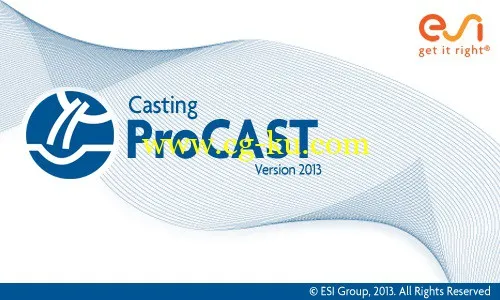
在整个制造业,铸造过程仿真模拟现在已作为一个重要的产品设计和过程开发的工具,用以提高铸件产量与质量。
ProCAST是业界领先的铸造过程模拟软件,基于强大有限元求解器和高级选项,提供高效和准确的求解来满足铸造业的需求。与传统的尝试-出错-修改方法相比,ProCAST是减少制造成本,缩短模具开发时间,以及改善铸造过程质量的重要的、完美的解决方案。

ProCAST提供了整体软件解决方案,能够进行完整的铸造工艺过程预测评估,包括充型、凝固、微观组织以及热力耦合模拟等,使得工艺设计人员可以很便捷地观察模具设计效果,在制造过程的早期阶段就能进行正确的选择与决策。
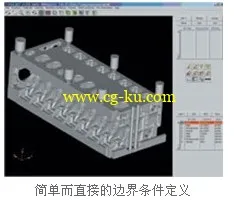
ProCAST广泛涵盖了各种铸造工艺与合金种类,包括:
·高压铸造、低压铸造
·砂型铸造,金属型铸造及倾斜浇注
·熔模铸造,壳模铸造
·消失模铸造,离心铸造
·连续和半连续铸造;
特点和规格
ProCAST是完整的模块化软件系统,包含了可拓展的应用模块与工程工具,以满足铸造企业具有挑战性的各种需要。各个模块具有很强的专用性,分别针对工艺过程的某一特定步骤:
·流动求解器——充型过程模拟,包括半固态材料、消失模工艺及离心铸造;
·传热求解器——凝固与收缩趋势预测,包括辐射选项;
·应力求解器——热应力及变形情况。
·此外,高级专用金相选项能够预测:
·气孔与微观缩孔;
·铁碳合金微观组织
·晶粒结构。
·ProCAST共有九个模块,下面分别阐述相应的功能。
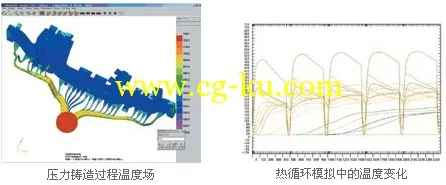
前处理器PreCAST
通过ProCAST图形用户界面可以定义各种边界条件。这些丰富的功能能够准确模拟所有铸造情况。所选需要施加边界条件的几何区域可以通过点击和自动选择延伸执行。用户定义的数据可以是不变的,也可以随时间或温度变化。
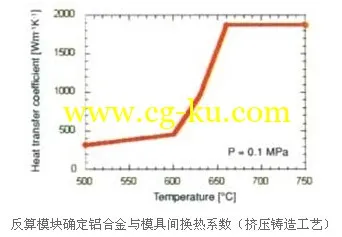
材料数据库
ProCAST提供了可扩展材料数据库,可用于模拟大多数合金,从钢和铁到铝基、钴基、铜基、镁基、镍基、钛基和锌基合金。目前,材料数据库还仍在持续不断地进行扩充,经过工业验证的完善的物性参数会及时添加进去。
此外,ProCAST还拥有独特的热力学数据库。该数据库允许用户直接输入合金化学成分,自动产生模拟所需的物性数据。
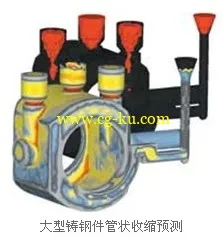
后处理器ViewCAST
ProCAST后处理器功能相当强大而多样,采用菜单和图标驱动方式,提供了下列变化过程的动态信息:
·金属液前沿流动
·卷气
·温度场
·压力云图
·凝固数据
·速度矢量
·应力和变形
·微观组织
ProCAST提供了多种方式,便于显示工艺结果,包括:
·云图
·矢量图
·截面及切平面
·X-Y曲线图
·动画,图片及影片输出
便于快速直接地交换信息和通讯,并可将模拟结果以不同的标准格式输出到其他CAE软件中。
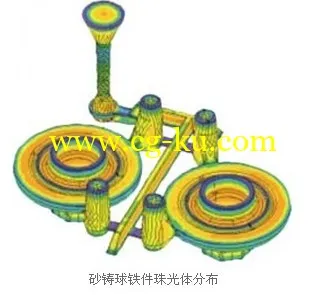
网格划分与工具
MeshCAST是ProCAST的CAD接口与网格生成模块。它将设计阶段与仿真阶段高效地联系在一起,能够快速完成创新性设计方案的准备工作,并实现快速而可靠的计算。
主要特点
·自动生成三维网格
·CAD/CAE几何通过STEP, IGES, 或Parasolid格式导入
·直接有限元网格导入
·快速的网格生成
·卓越的网格质量及质量检查
·处理复杂几何模型与多种材料
·边或表面网格密度可变
·保证流动分析的网格要求
·熔模铸造自动壳模生成

反算模块
ProCAST反算模块通过减小在给定的位置与时间上计算结果与实测温度的差距,确定材料属性或边界条件。
主要特点
·确定时间和温度相关的界面系数
·确定时间和温度相关的边界条件
·确定时间和温度相关的材料属性

流体求解器
ProCAST提供了一个卓越的流体流动功能来模拟充型过程。它耦合能量方程求解全三维N-S方程,自由表面前沿跟踪方法采用体积函数法(VOF),能够模拟凝固过程中自然对流和收缩引起的流动。
主要特点
·求解器全三维N-S流体流动方程
·倾斜浇注轴的旋转
·模拟卷气和排气的气体模型
·半固态材料的非牛顿流体模型
·过滤网模型
·湍流模型
·可压流体模型
·消失模模型
·颗粒跟踪方法
传热求解器
传热求解器通过考虑传导、对流和辐射现象实现传热计算。采用热焓方式描述与相变有关的放热过程,如凝固和固相转变。
主要特点
·瞬态,非线性三维热传导
·热对流和辐射
·采用热焓方式考虑相变
·缩孔缩松预测
·压力铸造和金属型铸造的热循环分析
·砂模铸造虚拟模具

应力求解器
ProCAST先进的应力求解器考虑了弹塑性或弹性-粘塑材料特性,能够实现传热、流体和应力的耦合模拟。简单材料模型,如弹性,空腔,或刚体,也能处理。
主要特点
·非线性应力分析
·自动接触设置与评估(传热和受力)
·气隙
·无限的模型尺寸
·随温度变化的机械性能
辐射
辐射模块扩展了传热求解器中的辐射处理能力,考虑了角系数的影响。该模块对所有的熔模铸造过程是必需的,因为从壳模的一个区域到另一区域的自辐射效应非常显著。
主要特点
·包括自辐射效应的准确传热分析结果
·单晶铸件辐射角系数自动更新
·模拟熔模完整工艺,包括壳型预热
·快速角系数算法
·应用MeshCAST中壳层选项产生壳体
气孔与微观缩孔预测
大多数模拟软件严格限定缩孔预测必须为金属液卷气引起的宏观缩孔,这种简化方法没有考虑气体与枝晶间收缩导致的微观缩孔。ProCAST提供了基于物理现象的独特方法,处理微观缩孔模型。
主要特点
·耦合宏观缩孔与管状收缩的显微缩孔预测
·糊状区压降
·气体分离
·气体溶解度作为温度和合金元素的函数
·气孔的形核和生长

微观组织
ProCAST微观组织模块可建立确定性模型,该模型可将铸件任意位置热变化同微观组织形核和长大过程耦合实现模拟。
主要特点
可用的确定性模型:
·等轴晶(DAS)
·耦合共晶
·球墨铸铁共晶(SGI)
·灰口/白口铁共晶
·球墨铸铁共析
·灰口铁共析
·包晶转变
·Scheil模型
·铁/碳固态转变
晶粒结构模拟
晶粒结构模块基于随机方法(细胞自动机CA)和有限元法(CAFE模型)的耦合,能够预测凝固态的晶粒结构。
主要特点
·预测柱状和等轴晶结构
·柱状晶到等轴晶转变
·柱状结晶区晶粒选择
·预测单晶铸件中杂散晶体
·晶体结构的演变
·立体信息
·晶粒结构直接可视化

显著优势
ProCAST基于成熟的有限元技术,具有明显的技术优势:
·精确的几何描述;
·单元数目剧减;
·高精度结果;
·多尺度、多种网格混合
能够满足最苛刻的工业需要:
重力铸造-砂型铸造、金属型铸造、倾斜浇注
重力铸造工艺成功的关键因素,在于优化浇注系统,消除可能的收缩区域。基于对各种合金收缩缺陷的精确预测,技术人员可在计算机上研究冒口位置、保温套或放热套的作用,并直接从屏幕上观察结果,以达到最佳的铸件质量。
熔模铸造-熔模铸造、壳模铸造
ProCAST设计了专用功能以满足熔模铸造厂的特殊需要。例如,ProCAST能够生成代表壳模的网格,该功能已考虑了非均匀厚度的混合与合并;含有角系数的辐射模型,包括阴影效应,可用于高温合金的熔模铸造工艺。

低压铸造
为重现工业生产条件,应进行模具循环模拟,直至模具达到稳定温度状态。根据模具的热状态、充型过程及凝固结果,就可以调整工艺参数,实现最优工艺质量,同时缩短产品面市时间。
压力铸造
ProCAST功能能够满足压力铸造,包括挤压铸造和半固态材料工艺,的特殊要求。压头最优速度曲线、浇口设计以及溢流槽位置确定等,可以采用模拟方法轻松完成,同样适用于薄壁结构铸件。
消失模工艺
消失模工艺的模拟要求详细的背压物理模型,需要考虑泡沫材料燃烧、涂料与砂子的渗透性等因素。ProCAST提供了精确的方法处理消失模工艺中的复杂物理现象。
应力分析-模具寿命,热裂
ProCAST具有处理传热、流动、应力耦合模拟的独特能力,这种全面分析可同时在同样的网格上完成。技术人员能够研究充型过程对模具的热冲击,凝固过程铸件与模具间气隙的影响等问题。热裂、塑性变形、残余应力与变形等是目前工业用户所关心的重要问题。

系统需求
ProCAST已经完成下列硬件平台的测试和验证
平台
处理器
操作系统
图形选项
PC计算机
英特尔32位
Windows 2000
Windows XP
3D card OpenGL
HP
PA-RISC
HP-UX 11.11
3D card X11 OpenGL
SGI
R1*000
IRIX64 6.5
3D card X11 OpenGL
SUN
UltraSparc II & III
SunOS 5.8
3D card X11 OpenGL
IBM
Power PC
Power 3 & 4
AIX 5.1
AIX 5.2
3D card X11 OpenGL
HP/COMPAQ
Alpha EV6
OSF1 - Tru64 5.1
3D card X11 OpenGL
Linux
Intel / AMD - IA32 bits
Redhat 7.3
Redhat 9.0
3D card Xfree86 4.2 OpenGL
科学出版
Computer simulation and analysis of investment casting process
Dr. S. Shamasundar, Mrs. Damayanthi Ramachandran, Mr. N. S. Shrinivasan, Manjunatha T. M
Gravity die casting process - die design process optimization
金属型铸造过程-模块设计过程优化
Dr.S.Shamasundar, V.Gopalakrishna, Manjunatha, Badrinath
Property Prediction with macro micro-modeling and computational thermodynamics
基于宏观微观建模与计算热力学的物性预测
Jianzheng Guo, Mark T. Samonds
CAE Techniques for Casting Optimization
CAE技术实现铸造过程优化
M J Marques, INEGI, Portugal
Mould Fill Simulation to Improve the Quality of a Component
应用充型过程模拟改善铸件质量
T Imwinkelried, H Homberger, Alusuisse Technology and Management Ltd, Switzerland
Application of Numerical Modelling in SSM Automotive Brake Calliper Castings
SSM轿车制动钳铸件数值建模的应用
N Jahajeeah, R Bruwer, O Damm, L Ivanchev, P Rossouw, K Sharma
National Product development Centre, CSIR, South Africa
Investment Casting Simulation
熔模铸造过程模拟
M Gaumann, A. Sholapurwalla, ESI Group
Simulating the Lost Foam Casting Process
消失模铸造过程模拟
A Paine, M Gaumann, M Gremaud, ESI Group
End User Applications
熔模铸造过程计算模拟与分析
Computer simulation and analysis of investment casting process
Please click here to view the second part of the document
Dr.S.Shamasundar, Mrs. Damayanthi Ramachandran, Mr.N.S.Shrinivasan, Manjunatha T. M
Investment casting process used for precision component manufacture calls for accurate methoding design. The development times can be very high in the conventional trial and error based process design. In the current competitive environment, there is a need for the foundry and casting units to develop the components and the process at quick response times. Further, the costs of development also have to be kept low to be competitive. In these circumstances, FINITE ELEMENT ANALYSIS based computer simulations can be of immense value to the casting units. Authors have used ProCAST a commercially available FEM package for foundry and casting simulation for analysis of investment casting of a variety of components. (ProCAST can be used as a simulation tool for analysis of other casting processes such as sand casting, high pressure / gravity / low pressure die casting as well. However these are not part of the focus of this particular paper). By computer simulation of the casting process, the flow of the molten metal in the cavity, the heat transformation, the solidification, grain formation, shrinkage and stress evolution can be visualized. The details are seen on the computer in graphical form, which helps the designers to visualize the defects in the process design, to analyze the causes for the defects (such as hot tears, shrinkage porosities, cold shuts etc.). Further, the modified gating designs can be tried without resorting to the actual production of tooling. In investment casting process, the shell making, shell drying, shell heating and casting processes can be simulated in ProCAST. The paper describes general principles of applying finite element analysis computer simulation to investment casting processes. Prediction of defects such as shrinkage porosity is demonstrated. Using of computer simulation as a virtual investment-casting environment is demonstrated.
Gravity die casting process - die design process optimization
Dr.S.Shamasundar, V.Gopalakrishna, Manjunatha, Badrinath
The design of dies, gating and risering system in gravity die casting or permanent mould casting by conventional approach is a difficult process and time consuming. Gravity die casting used for non-ferrous casting applications is increasingly used in the foundries today as an economically viable casting process. The conventional trial and error based die design and process development is expensive and time consuming. Such a procedure also "Times New Roman" might lead to higher rejections and lower casting yield. Further any changes and modifications to be incorporated to the die design, involves metal cutting and reshaping. Computer simulation procedure based process development and die design can be used for rapid process development and die design in a shorter time. Such a computer simulation based procedure, often using state of the art FINITE ELEMENT ANALYSIS based software systems, can improve the quality and enhance productivity of the enterprise by way of faster development of new product. FEM based simulation software systems help the designer to visualize the metal flow in the die cavity, the temperature variations, the solidification progress, and the evolution of defects such as shrinkage porosities, cold shuts, hot tears and so on. Authors have applied FEM simulation to design and develop a variety of Aluminium gravity die casting processes. The components include a gear casing and a manifold. In this process different options of gating design studied by FEM simulation, and the resultant patterns of solidification are discussed.
Property Prediction with macro micro-modeling and computational thermodynamics
Jianzheng Guo, Mark T. Samonds
Part of the challenge of designing a new alloy is understanding the relationships between the alloy chemistry, the processing, and the final properties of an in-service part made from that alloy. The prediction of local mechanical and thermal properties is possible, to a degree, given knowledge of the microstructure, phase fractions, and defects present in a metallic part. Multi-component micro models of solidification, coupled with macro-scale thermal and fluid flow processing conditions, including macrosegregation, have recently been coupled with computational thermodynamics in a commercial software, ProCAST, to form the basis of this type of prediction. Subsequent solid state transformations through heat treatment can also be taken into account.
CAE Techniques for Casting Optimization
M J Marques, INEGI, Portugal
During recent years the application of some popular commercial software as computer simulation tools has become widely accepted within the foundry industry, leaving the idea of the simulation as luxurious tools. The application of casting simulation has been most eneficial for avoiding shrinkage scrap, imporving cast metal yield, optimize the gating sustem design, optimizing mold fillig and finding the thermal fatigue life in permanent molds. Several case studies demonstrate the benefit of using these tools under industrial conditions. nopwadays, in Finland, the foundries that cover around 90% of the production of the cast machine components use casting simulation as an evryday tool. This paper will demonstrate the application of the ProCAST software. Simulation resulted in gating system and moulding changes that reduced the weight of the total casting from 59kg down to 46kg. Maintaining casting quality the yield has increased by 9%. Some experiments were carried out under foundry conditions to compare the results.
Mould Fill Simulation to Improve the Quality of a Component
T Imwinkelried, H Homberger, Alusuisse Technology and Management Ltd, Switzerland
High pressure die casting of large magnesium components is a very cost competitive technology for light weight designs. As many functions can be integrated into a single part, significant assembly cost can be saved. Besides the weight savings, dealing with a single integral part can be of particular interest for a given application. For an instrument panel, the high specific stiffness, the resulting damping characteristics, the excellent mass tolerances are such advantages as well as the absence of rattling noises which can be a nuisance with assemblies. The production of large high quality magnesium components requires high competence with regrad to mould construction, metallurgy and die casting technology. Numerical simulation of mould filling and solidification is an invaluable method to the construction engineer as the complexity of the interactions during mould filling goes beyond human imagination. These simulation tools have become a powerful mean in identifying defects and for the optimisation of moulds.
Application of Numerical Modelling in SSM Automotive Brake Calliper Castings
N Jahajeeah, R Bruwer, O Damm, L Ivanchev, P Rossouw, K Sharma
National Product development Centre, CSIR, South Africa
Numerical modelling has successfully been used as an efficient tool to convert a gravity cast brake calliper to a thixocasting process. The thixo-module of ProCAST has been used for the modelling process to obtain optimal processing parameters. Results from interrupted shot castings show excellent correlation with the fluid dynamics and flow pattern of the model. The level and location of porosity revealed by non-destructive x-rays and microscopic analyses showed good correlation with the model prediction.
Investment Casting Simulation
M Gaumann, A. Sholapurwalla, ESI Group
In the current environment, investment casters need to stay on the cutting edge of new technologies to remain competitive in the marketplace. The capability to produce investment casting components of high quality while at the same time reducing product costs and development times is the challenge the foundry industry faces today. Increasingly complicated parts are being made through the investment casting process with less castable alloys. Computer aided modelling has been helping the foundry industry for the past several years, not only with the design of new components, but also in the redesign of existing products. By eliminating product defects and reducing scrap and rework, the investment caster can achieve improvements and more consistent product quality and obtain higher yields.
Simulating the Lost Foam Casting Process
A Paine, M Gaumann, M Gremaud, ESI Group
Throughout the manufacturing industry, process simulation software has been accepted as important tools in product design, process development, improving yield and in solving processing problems. The lost foam casting process, also known as the evaporative pattern process, involves casting liquid metal into a non-vacant sand mould filled with a combustible polymeric material. The foam disappears as the molten liquid enters the mould, causing the progressive burn-out of the foam pattern. The metal precisely replaces the foam pattern to form an identical geometric copy of the pattern. Although there has been a rapid increase in the use of the lost foam casting process (LFC) world wide, there has also been extensive research work allowing more understanding of the process which, even though continued RD effort is needed, this has allowed the development of accurate and predictive lost foam simulation software. Along with the large benefits associated with lost foam casting there is also the increased risk of producing defected components due to the strong requirement for precise process control. Thus, in order to get a good understanding of the process, there has been a strong drive from industry to produce mathematical models which are used to accurately simulate the lost foam casting process. The complexities associated with modelling this process, which involves numerically coupling the heat transfer, the fluid flow, the foam evaporation and the gas transport, makes this certainly one of the most challenging processes to simulate. Various industrial cases are presented in the paper showing applications of the simulation software ProCAST in lost foam casting.
Name: ESI GROUP PROCAST
Version: V2013.0
Interface: english
OS: WinALL
Size: 294 mb
Thank LND team!